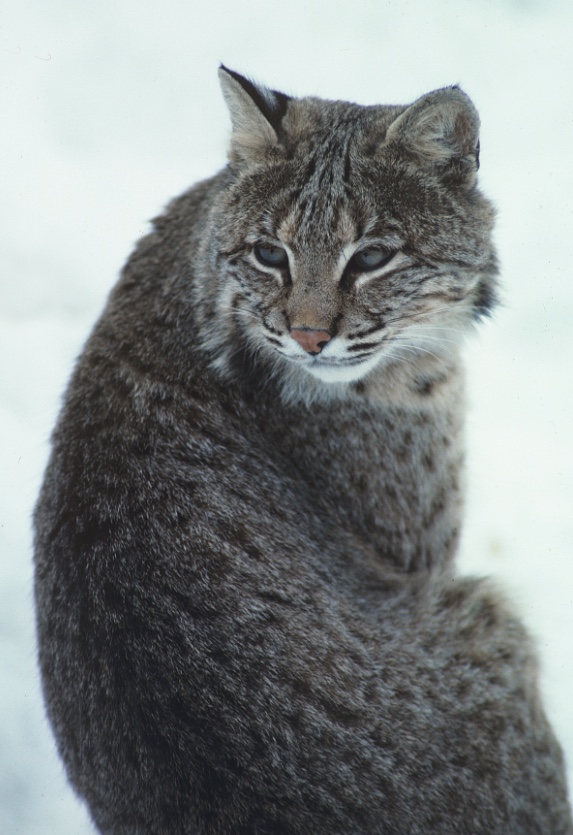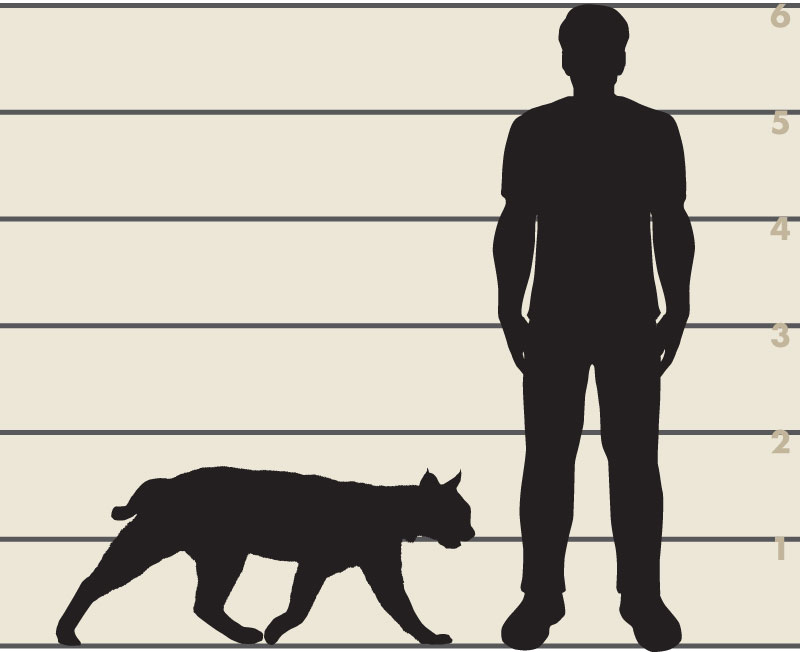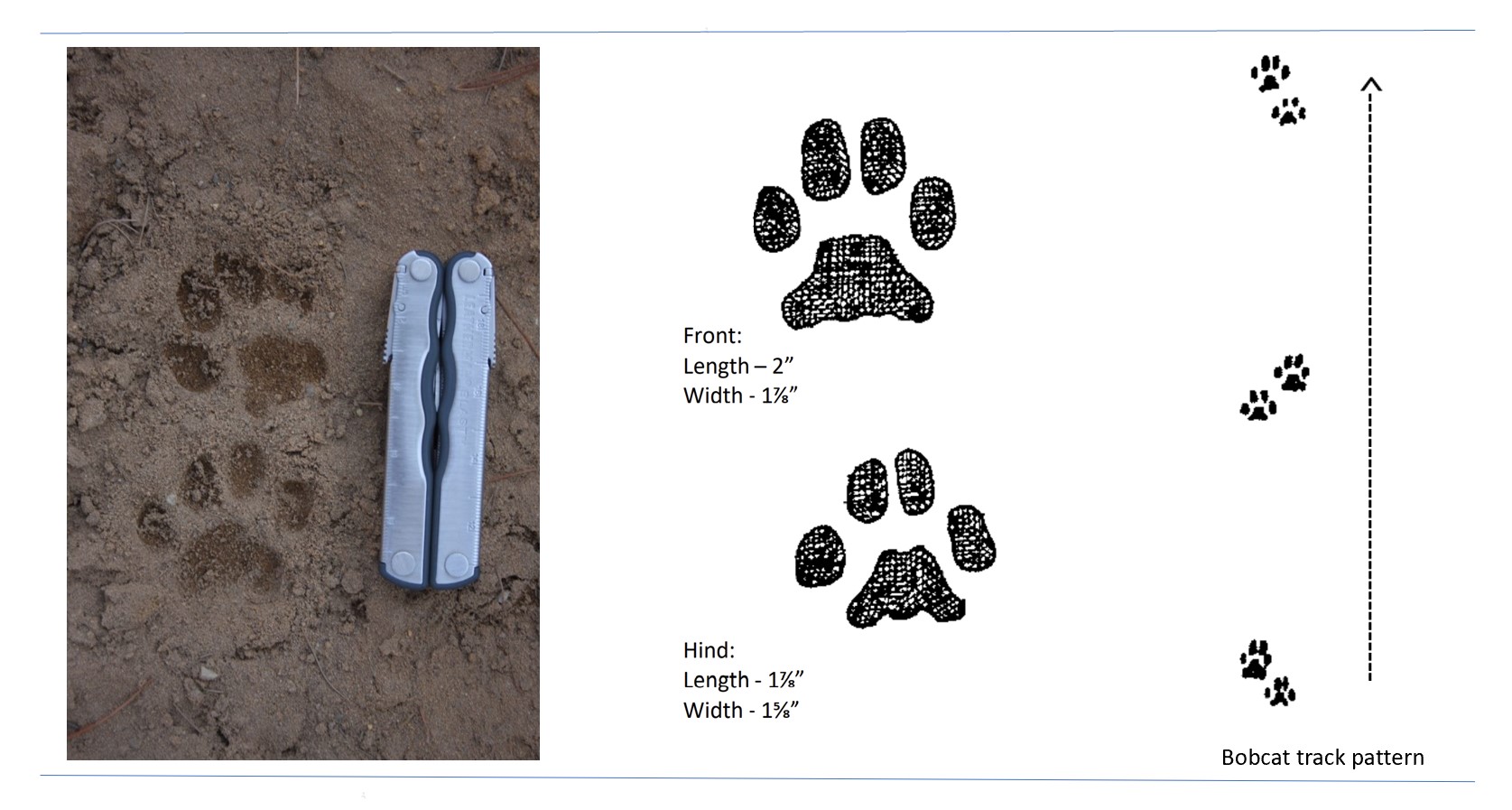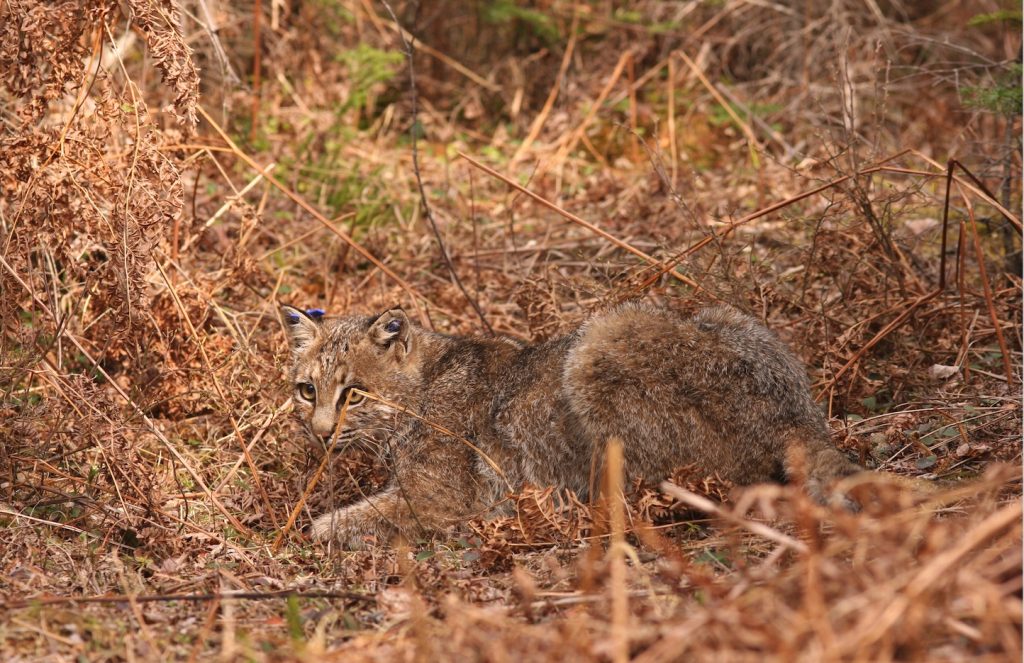
Learn more about bobcats in Illinois in OutdoorIllinois Journal:
Illinois Bobcat Hunting and Trapping Season Review, 2016–2020
As bobcats are fierce predators, they keep local populations of mice, voles, rabbits and other small mammals under control, which benefits the plant community.
Bobcats belong to the Felidae family. They are approximately 2¼ to 3½ feet in length, including the tail, and can be up to 2 feet high at the shoulder.
Adult males can weigh up to 40 pounds but average 22 pounds; adult females are smaller and weigh slightly less.
Bobcats have yellowish to reddish brown fur with black spots and streaks throughout. In winter, the fur tends to be more grayish-brown. The fur on the underparts is white with dark spots.
Bobcats have a ruff of fur extending from the ear to the lower jaw, tufted ears (usually), long legs, and a short tail (4 to 6 inches). The tail is whitish underneath and brown above, with dark bands and ending in black with a white tip.
Bobcats have 5 toes on the front feet and 4 toes on the rear feet.
Bobcat tracks are round and do not show claw marks. Front prints average 1¾ to 2¼ inches long, with rear prints slightly smaller.
Bobcat scat may contain fur but not bones; the scat tends to be highly segmented. It is common for bobcats to cover their scat. They also make scrapes near dens or along trails where scat is left uncovered to help mark the bobcat’s territory.
Bobcats were almost extirpated from Illinois by the mid 1900s. They were protected as a threatened species in Illinois from 1977 to 1999. Today, they can be found throughout Illinois but are more common in the southern third of the state. Bobcat home ranges can be quite large. A study conducted in southern Illinois reported annual home ranges of 7½ to 20 and 3½ to 6 square miles for male and female bobcats, respectively.
Due to the expansion and increasing abundance of bobcats in Illinois, a regulated bobcat season was initiated in 2016. Bobcat harvest is regulated by the IDNR to maintain a healthy population that offers opportunities for hunters and trappers but ensures a stable or growing population. The bobcat population is anticipated to continue growing throughout the state, especially along major rivers and forested areas.
Bobcats are typically quiet animals, but they occasionally growl or make high-pitched screams. During the breeding season they may also vocalize using squalls, howls, meows, and yowls. Male bobcats are solitary animals; the young of the year stay with the females from spring until fall. Bobcats are active from a few hours before sunset until dawn.
Bobcats help control small mammal populations.
Bobcats can be carriers of feline distemper and rabies. Feline distemper is not known to be transmittable to humans. Rabies can be transmitted to humans and is generally fatal if not treated quickly.
Bobcats prefer forest with a dense understory. Wooded habitat is used for cover and denning sites, while forest edges and fields are used for hunting prey.
Bobcats are classified as carnivores. They feed mainly on rabbits, mice, voles, and squirrels, but bobcats will also eat many other species, including muskrat and opossum. They are also known to consume birds, frogs, insects, fish, and snakes. Occasionally a bobcat may take poultry.
Bobcats will also kill deer. Fawns and injured or sick deer are prey for bobcats, but they are also capable of killing healthy, adult deer. They can ambush a deer when it is resting in its bed or attack during periods of deep snow. Large prey are often covered (cached) to protect the carcass from scavengers.
Breeding takes place from January through June, with the peak in February and March. Gestation is approximately 60 days. Bobcats have one litter each year, with an average of 2 to 3 kittens per litter. The kittens have spotted grayish-brown fur, and their eyes open when they are about 9 to 11 days old. They are weaned by the time they are 2 months old but stay with the female until at least the fall of their first year. Only the female provides for the young. Females begin breeding at one to two years of age, while males do not breed until their second year.
To minimize the presence of bobcats, control rabbit and small mammal populations by keeping the area cleared of brush or other cover.
Bobcats are good climbers, so fences are not very effective in keeping them out. To protect poultry, provide enclosures that have a solid or secure wire roof. Providing a shed or other solid enclosure will help protect poultry better than a wire enclosure. All doors or other openings should be shut at night.
There are currently no approved repellents for bobcats in Illinois.
Frightening devices such as flashing lights, blaring music, or dogs may temporarily discourage bobcats from using an area. However, once the bobcat learns that these pose no threat, they will no longer keep the animal away.
Bobcats may be hunted or trapped by licensed sportsmen or women with a valid bobcat permit. Due to the limited number of permits issued, some nuisance bobcats may need to be removed under a nuisance animal removal permit issued by a district wildlife biologist.
If a bobcat is taking poultry or causing problems that cannot be resolved by improving fencing or implementing recommendations from a biologist, a nuisance animal removal permit may be issued. A nuisance wildlife control operator may also be hired to help remove problem bobcats.
Your local district wildlife biologist can provide options for resolving problems, including issuance of a nuisance animal removal permit.
The IDNR Furbearers page provides more information about hunting and trapping Furbearers. The Illinois Trapper Education Manual provides guidance on the best management practices for trapping. Trap size recommendations for bobcats are found on page 90; see TrapperEducationManual.
Current hunting and trapping seasons can be found in the Illinois Digest of Hunting and Trapping Regulations or in the Legal Status section below.
Recreational fur trapping (and hunting when and where allowed) is the preferred method to deal with nuisance furbearer issues. Trapping can help control the local population of animals and, in some cases, reduce the number of nuisance complaints and the damage that some species can cause. The IDNR offers a lengthy trapping season (3 months, in some cases 4½ months). Legal trapping can occur 100 yards from an occupied dwelling without permission of the occupants, closer with permission as long as there are no municipal ordinances that prohibit trapping.
In Illinois, bobcats are protected as Furbearers by the Illinois Wildlife Code. A bobcat permit and a hunting or trapping license are needed before attempting to harvest a bobcat. A bobcat may also be removed under authority of a nuisance animal removal permit if an Illinois Department of Natural Resources district wildlife biologist determines that it is causing damage to property or threatening human health or safety. Your local district wildlife biologist can provide options for resolving problems, including issuance of a nuisance animal removal permit.
Bobcats may be hunted or trapped by permit holders mid-November through mid-February, except during firearm deer season in counties with firearm deer hunting. A bobcat registration permit must be purchased by lottery permit holders within 48 hours of taking a bobcat. This is not required if the bobcat is taken under a nuisance animal removal permit. Hunting and trapping season dates and current regulations are found in the Illinois Digest of Hunting and Trapping Regulations.
Illinois Department of Natural Resources biologists monitor the number of bobcats in Illinois to ensure that hunting and trapping do not negatively impact the population. For more information, visit the IDNR Bobcat Hunting and Trapping page.

Photo: Michael Jeffords

Illustrator: Lynn Smith

Photo: Jared Duquette and Illustrations: Dan Goodman

Photo: Jared Duquette
The Wildlife Illinois website was authorized by the Illinois Department of Natural Resources (IDNR) in partial fulfillment of project W-147-T. The website was developed by the National Great Rivers Research and Education Center, 2wav, and the IDNR in partnership with the United States Department of Agriculture Animal and Plant Health Inspection Service Wildlife Services and University of Illinois Extension to provide research-based information about how to coexist with Illinois wildlife.